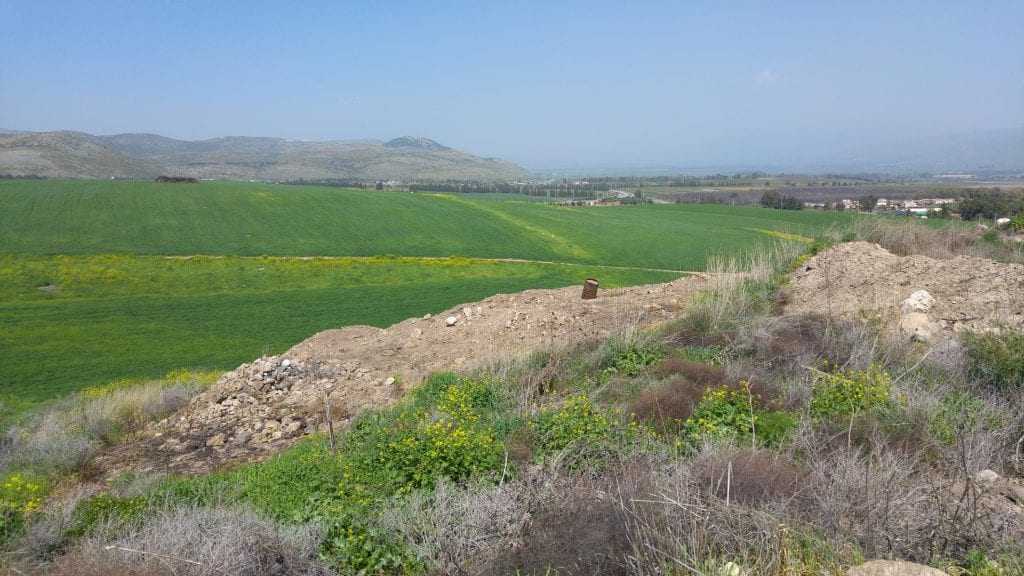Biblical Tours is a special series highlighting a collection of sites in the Holy Land as told by Israel’s very own tour guide, Gary Littwin. Familiar passages will literally take on new life and new meaning. You will absolutely feel the connection and the tangible, for-real bond which connects modern Israel and all of us to ancient Israel. Be prepared for some surprises as well!
—
Today we’ll be traveling to the center of the Galilee panhandle, to the ancient city of Hazor.
Hazor existed as a thriving city for just over 2,000 years with its beginnings in the early Bronze era, approximately 4,500 years ago. It’s quiet now with far fewer visitors than many other Biblical sites. Amidst the rural silence, it’s sometimes hard to imagine the tumult, sound, and fury which characterized this site in ages past. But with a little imagination, accompanied by the Bible, the stories become real again.

The city was located on the strategic road between Egypt and Mesopotamia (present-day Iraq and Syria). In its Canaanite heyday, it was the largest city in this part of the world, covering an area of nearly 250 acres with a population of close to 20,000 people. Hazor is mentioned in documents dating to the 18th century BCE found in Mari, present-day Syria, and Egyptian letters from the 14th century BCE. These documents reveal a period of instability at the end of which, in the 13th century BCE, Hazor was destroyed by a massive fire. Modern archaeologists have in fact detected signs of the conflagration.
In the book of Joshua, we read how Jabin, king of Hazor and leader to all the Canaanite kingdoms in the region, recruited a coalition of kings and princes to fight Joshua and the invading Israelites. With God’s assurance of victory, Joshua defeated the Canaanite kings and burned the city.
And it came to pass, when Jabin king of Hazor heard thereof, that he sent to Jobab king of Madon, and to the king of Shimron, and to the king of Achshaph, and to the kings that were on the north, in the hill-country and in the Arabah south of Chinneroth, and in the Lowland, and in the regions of Dor on the west, to the Canaanite on the east and on the west, and the Amorite, and the Hittite, and the Perizzite, and the Jebusite in the hill-country, and the Hivite under Hermon in the land of Mizpah. And they went out, they and all their hosts with them, much people, even as the sand that is upon the sea-shore in multitude, with horses and chariots very many. And all these kings met together, and they came and pitched together at the waters of Merom, to fight with Israel. And the LORD said unto Joshua: ‘Be not afraid because of them; for to-morrow at this time will I deliver them up all slain before Israel; thou shalt hough their horses, and burn their chariots with fire.’ So Joshua came, and all the people of war with him, against them by the waters of Merom suddenly, and fell upon them. And the LORD delivered them into the hand of Israel, and they smote them, and chased them unto great Zidon, and unto Misrephoth-maim, and unto the valley of Mizpeh eastward; and they smote them, until they left them none remaining. And Joshua did unto them as the LORD bade him; he houghed their horses, and burnt their chariots with fire. And Joshua turned back at that time, and took Hazor, and smote the king thereof with the sword: for Hazor beforetime was the head of all those kingdoms. And they smote all the souls that were therein with the edge of the sword, utterly destroying them; there was none left that breathed; and he burnt Hazor with fire. (Joshua 1:1-11)
The Canaanites in Hazor did manage to recover somewhat, as a later Canaanite king based in Hazor, also named Jabin, again threatened Israel. Deborah, the prophetess and judge in Israel at that time, together with General Barak Ben-Avinoam led the Hebrew warriors of the tribes of Naphtali and Zebulon to victory over a far more powerful and better armed Canaanite force led by the Canaanite general Sisera at the foot of nearby Mt. Tabor.
Now Deborah, a prophetess, the wife of Lappidoth, she judged Israel at that time. And she sat under the palm-tree of Deborah between Ramah and Beth-el in the hill-country of Ephraim; and the children of Israel came up to her for judgment. And she sent and called Barak the son of Abinoam out of Kedesh-naphtali, and said unto him: ‘Hath not the LORD, the God of Israel, commanded, saying: Go and draw toward mount Tabor, and take with thee ten thousand men of the children of Naphtali and of the children of Zebulun? And I will draw unto thee to the brook Kishon Sisera, the captain of Jabin’s army, with his chariots and his multitude; and I will deliver him into thy hand. (Judges 4:4-7)
Deborah’s army prevailed despite their lack of iron chariots of which the Canaanites had 900! Sisera fled and was killed by Yael, wife of Heber the Kenite. In praise of God for His miracles, Deborah composed a song known as the Song of Deborah. The entire story can be found in Judges Chapters 4-5.
By the 10th century BCE, during the period of the United Kingdom under David and Solomon’s rule, the city was firmly in the hands of the Hebrews. The book of Kings tells how the city, along with Megiddo in the valley of Armageddon, and Gezer in the Judean plain, was fortified and expanded by King Solomon.
And this is the account of the levy which King Solomon raised; to build the house of the LORD, and his own house, and Millo, and the wall of Jerusalem, and Hazor, and Megiddo, and Gezer. (I Kings 9:15)
Ancient Hazor met its untimely end in 732 BCE during the Assyrian invasion led by Tiglath-Pileser the Third. The city was captured and utterly destroyed by fire.
One of the first sites that greets the visitor at Hazor is the massive six-chambered gate built during the time of King Solomon. Gates of this type and construction were very typical of Israel and can also be found at other ancient cities such as Megiddo, Gezer, and Kiafa.

A bit further on we come to the remains of a typical Israelite home, which archaeologists have termed the “house of four spaces.” This type of structure for the home can be found throughout all of ancient Israel.
Near the house is one of the most impressive structures excavated at Hazor: the Canaanite Palace, used during the 13th and 14th centuries BCE, with many of the original mud bricks still intact.

At the western limit of the city, you’ll see an Israelite watchtower, which was built in response to the approaching Assyrian army.

The highlight of the area is the water system. Built at the time of King Ahab of the Northern kingdom of Israel in the 9th century BCE, the water system provided residents with a steady water supply during the siege. At first glance the view is rather dizzying: a massive shaft reaching 180 feet underground to a spring fed by the Hazor stream. The adventurous visitor can walk down to the underground water source exactly as did the Hebrew citizens of the town 2,900 years ago.

The nearby kibbutz of Ayelet HaShachar hosts a small but fascinating museum filled with priceless artifacts which were recovered during the excavations at the historic Tel Hazor.
Part 1 of the Galilee Panhandle – Dan can be found here.
For all of Gary’s Biblical Tours, click here.
For tours with Gary, he can be reached at gary.littwin@gmail.com.





